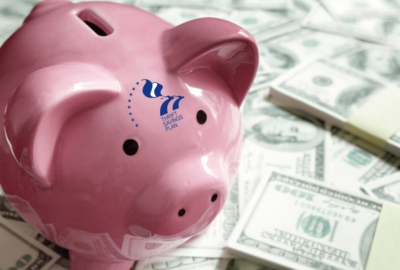The three-legged stool of federal retirement might have a fourth leg
Federal retirement tends to stand like a three-legged stool: the FERS annuity, the Thrift Savings Plan and Social Security. But a fourth leg could make for an...
Federal retirement tends to stand like a three-legged stool: the Federal Employees Retirement System (FERS) annuity, the Thrift Savings Plan and Social Security. But a fourth leg could make for an even sturdier retirement. Good old fashioned Savings Bonds are another instrument federal employees can invest in for their personal savings. Federal Drive with Tom Temin got more from retired federal manager and financial counselor Abe Grungold.
Interview transcript:
Abe Grungold There would be an employee from every agency who was the bond coordinator and they would pass out the United States savings bonds pamphlets that you could obtain in the bank, along with a payroll allotment card, and you could select the amount of the bond that you wanted and how frequent you wanted to receive it. So you could buy $50 bond or $1,000 bond. And if you did the 50, you get 26 bonds, one every pay period. If you did the $1,000 bond, say $100 bond, you wouldn’t get it every 26 pay periods, you would get it once a month, because you’d only be contributing $25 or however you wanted to do it. So this was an excellent program that the government offered for employees to do tax deferred savings before there was a TSP. Then when the TSP was introduced, they continued the program. Unfortunately, technology has now ended that bond drive that they would have every year. And the Treasury wants everyone to have an online account, not to purchase them and to get a paper bond. We would receive them in the mail when you bought them or some people actually had them sent to the office. It ended a wonderful program, because unfortunately, what happened was the government put it on the responsibility of the employee and they weren’t aware about it, because the annual bond drive sort of educated employees and it gave them an opportunity to think about it. So I think that is somewhat lost now. [Office of Personnel Management (OPM)] does have that literature there that you can go in and search out U.S. savings bonds and it takes you to the area where it says you have to do it through the Treasury direct. And again, it’s tax deferred savings. It was available before there was a TSP. Now that there’s the TSP, it’s still an excellent investment in addition to your TSP, in addition to your first annuity. And it gives you that tax deferred benefit where you can hold on to it for 30 years. Here I am, 65 years old. I now have a $10,000 savings bond that I purchased for 5,000 and it’s worth 16,000. And I have to pay the taxes now when I cash it in. Not years ago when I was trying to grow it. So it does provide an excellent tax deferred investment, even today for employees.
Drew Friedman If that is the case, then this can be a valuable tool for federal employees. Can you explain more how that can combine with other aspects of retirement for federal employees?
Abe Grungold Today, federal employees have a three-legged stool for their retirement. They have their FERS annuity. They have their thrift savings plan and they have Social Security. It’s called the three- legged stool. But if you have personal savings, such as the United States savings bonds, that provides a fourth leg to the stool, a more secure retirement. Because let’s say you don’t receive that first annuity, because you didn’t put in enough years of federal service. So now you’re really only have three legs to your stool. You have your TSP, you have your Social Security and you have your savings bonds. It’s just another important investment vehicle for you, the plan for your retirement. You should always be thinking about saving for retirement, and certainly the government will give you the annuity, you will get Social Security. If you invest properly and contribute, you’ll have your thrift savings plan. And the savings bonds gives you an opportunity for an emergency investment during your life, during your career, that maybe something comes up like the rainy day fund. This is your rainy day investment, and they’re good for 30 years. The E bonds earn 2.1% now, and the I bonds earn 6.89% presently. So you can save it for 30 years until they reach maturity and then cash them out when you’re in retirement. And you’re in a lower tax bracket, and maybe, the money will become very necessary for you to maybe pay for your grandchildren’s college fund, or maybe you want to go on a trip or buy a motorcycle, whatever you want to do in retirement, that money will come in handy. And I purchased them my entire federal career, and now that that I am retired, I have many that are coming to maturity and they’re coming in at the right time for me to use them.
Drew Friedman Is there a right time to purchase a bond? You said that you’ve purchased them throughout your career. Is there, one time that might be better than another to start doing this?
Abe Grungold I think it’s very important to start buying them early in your life, because like everything, you get in the habit of doing it. You can start off small buying the $50 savings bond or the hundred dollar savings bond, and then work your way up. And then, if you do it consistently, you will be amazed how much this account can grow over time. I’m planning for my daughter’s wedding the day she was born. I plan to repair my roof the first day I bought my home. I know these expenses may come down the road and it’s a great way to save, it’s a great way to defer paying taxes on your income. And it’s really the rainy day fund, the nest egg. And you really should get in the habit of doing it periodically. It will become second nature to you when you do that. And I would always buy a savings bond usually at the end of the year when I knew I had some extra money. Sometimes I purchased it with my tax refund, I would get a sizable tax refund and I would take that tax refund and immediately use it to purchase a savings bond. And if you do that alone, that alone with your tax refund, if you’re fortunate to get that tax refund, I think you will be amazed over a 30 years how much you can save and how much it will build up.
Drew Friedman You touched a little bit on this earlier, but there are, of course, different types of bonds available. Can you tell me a little bit more about what are maybe some of the benefits of each different type of bond? And how much money are we really talking about here that you could come out at the other end with?
Abe Grungold There are two major types of savings bonds. The EE bond, which presently earn 2.1%, and then they’re the I bonds. Now the the I bonds earned 6.89%. Now, these interest rates change every six months. The E bonds you can purchase an unlimited amount of E bonds. The I bonds presently, you can only purchase $10,000 worth of I bonds a year. When you buy them and you hang on to them, I had a client and they basically, this is all they purchased. They didn’t invest in the stock market, they didn’t invest anywhere, but they purchased savings bonds. And they accumulated almost $700,000 in savings bonds just by purchasing $1,000 savings bonds. And then during their lifetime, those bonds actually matured, and $1,000 savings bonds can turn into 10 or $15,000 at maturity, depending on the interest rate over the life of that bond. So they took their matured savings bonds and bought bigger savings bonds over time. So it wasn’t the $1,000 savings bonds. They started buying $10,000 savings bonds. When you reach old age and retirement, you have to think about long-term care going to a nursing home. And this is a important savings vehicle for you to fund those years if you need it.
Drew Friedman If there was one piece of advice or one key takeaway here that you’d want federal employees to know, what would that be?
Abe Grungold I want them to know that they have to think about saving. It’s not something that people think about when they start their position, but you have to think about your retirement. You have to think about savings. And I’ll give you a perfect example, say you’re a federal employee, and you’ve been in ten years now as a federal employee, and your subject to a furlough. I went through a furlough for 30 days, 35 days was the longest furlough, I believe it was in 2018- 2019. And I had emergency savings to carry me through that furlough. If you do not have an emergency savings account, how were you going to pay your rent, your food bill, all these necessary bills that come in during a furlough? The savings bond would be your savior to that cashing in savings bonds to pay your rent, to pay your food bill. It’s not just for retirement, it’s a emergency tax deferred savings. And this is very important. Yes, federal employees have to save in their TSP. It’s vital. It’s so important. Yes, you have to have money in your bank account to pay your daily bills. But what happens if there’s an unforeseen expense? And United States savings bonds can provide that safety net for employees. Young federal employees, mid-year federal employees, try to start saving.
Copyright © 2025 Federal News Network. All rights reserved. This website is not intended for users located within the European Economic Area.
Tom Temin is host of the Federal Drive and has been providing insight on federal technology and management issues for more than 30 years.
Follow @tteminWFED





